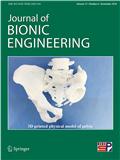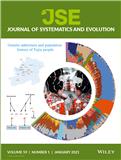
表型组学(英文)(Phenomics)杂志国级普刊
- 知网目次
- 维普目次
- 主管单位:
教育部
- 主办单位:
复旦大学
- 国际刊号:
2730-583X;EISSN 2730-5848
- 国内刊号:
31-2207/Q3
- 创刊时间:
- 期刊类别:
- 出版社:
- 主编:
- 发行周期:
双月刊
- 审稿周期:
个月
- 被引次数:
- 邮发代号:
- 全年定价:
- 他引率:
- 邮编:
- 影响因子:0
- 期刊分类:
- 发文量:
- h指数:
- 立即指数:
- 引用半衰期:

教育部
复旦大学
2730-583X;EISSN 2730-5848
31-2207/Q3
双月刊
个月
------/有基金-100.0%--https://www.editorialmanager.com/pnmc
《表型组学(英文)(Phenomics)》期刊已被查看: 次
/有基金 100.0%
杂志社官网:https://link.springer.com/journal/43657
投稿邮箱:phenomics@ihup.org.cnphenomics@fudan.edu.cn
主管单位:教育部
主办单位:复旦大学
地址:
邮编:
邮发:
全年定价:;欢迎广大学者朋友联系表型组学(英文)(Phenomics)杂志社投稿订阅!
注意:本站并非《表型组学(英文)(Phenomics)》杂志社官网,不提供征稿投稿服务,仅整理介绍该杂志内容!投稿请直接咨询杂志社!
1、投稿方式:在线投稿。
2、官网网址:https://link.springer.com/journal/43657
3、投稿系统:https://www.editorialmanager.com/pnmc
4、上海国际人类表型组研究院官网:
https://www.ihup.org.cn/jsp/phenomics/phenomicsInfo.jsp
5、编辑部邮箱:phenomics@fudan.edu.cn(公众号信息)
phenomics@ihup.org.cn
6、出刊日期:双月刊,逢双月出版。
2024年3月27日星期三
《表型组学(英文)》(Phenomics)期刊获批国内统一连续出版物号(CN号)
【微信公众号“复旦科技订阅号”信息】
人类表型组计划 复旦科技订阅号 2024-04-10
2024年4月,国家新闻出版署同意创办《表型组学(英文)》(Phenomics)期刊,国内统一连续出版物号(CN号)为CN31-2207/Q3,英文,双月刊,16开,公开发行,主管单位为教育部,主办单位为复旦大学,出版单位为复旦大学出版社有限公司。本期刊办刊宗旨为刊发表型组学研究领域重大前沿成果,服务人类表型组国际大科学计划,搭建国内外学术交流平台,提高我国在该领域的科研水平和国际影响力。
期刊介绍
《表型组学(英文)》(Phenomics)期刊聚焦表型组学前沿研究,通过搭建全球表型组学领域专家交流的国际平台,推动该领域相关的理论创新和学科发展。
本刊由复旦大学主办,与上海国际人类表型组研究院以及施普林格•自然(Springer Nature)集团合作出版,于2021年1月正式上线,双月刊, 一审决策时间为8天(中位数),已被PubMed Central(PMC)、ESCI等数据库收录,并于2022年入选了中国科技期刊卓越行动计划高起点新刊项目。
《表型组学(英文)》(Phenomics)期刊拥有高水平国际编委团队:由来自20个国家的84位顶尖科学家组成编委团队,含10位国内国际院士,37位国外编委,48位青年编委;主编为复旦大学金力院士,副主编为美国系统生物学研究所Leroy Hood院士、澳大利亚莫道克大学Jeremy Nicholson院士、德国莱布尼兹环境医学研究所Jean Krutmann院士、第三军医大学病理学研究所所长卞修武院士、华中科技大学同济医学院院长邬堂春院士、东南大学附属中大医院院长滕皋军院士以及复旦大学唐惠儒教授,执行主编为复旦大学丁琛教授。
衷心感谢《表型组学(英文)》(Phenomics)期刊编委团队、编辑部团队以及同行评议专家们的投入与付出,期刊作者以及广大读者对本刊的信任与大力支持!欢迎各位同仁踊跃投稿!
投稿方式
投稿网址:https://www.editorialmanager.com/pnmc/
编辑部邮箱:phenomics@fudan.edu.cn
《表型组学(英文)》(Phenomics)投稿指南
【官网信息】
Phenomics
Submission guidelines
Instructions for Authors
Types of Papers
Phenomics publishes Articles, Reviews, Commentaries, Brief Communications and Correspondence.
Articles do not have an upper word count limitation but would normally be less than 10,000. Articles must include: a title, an abstract, keywords, abbreviations, introduction, materials and methods, results, discussion, references, as well as figures and legends (less than 10 items).
Reviews are usually solicited by a personal invitation to the author, but unsolicited contributions are also considered. Reviews are expected to contain less than 10,000 words (including references).
Commentaries published in Phenomics are usually commissioned by the editors, but the unsolicited contributions can be considered. Commentaries typically contain less than 2,000 words (including references) and no more than 3 figures or tables.
Brief Communications should contain less than 1,000 words (including references) and no more than 2 figures and/or tables.
Correspondence items should contain less than 1,000 words (including references).
Peer-review policy
Peer-review is the system used to assess the quality of a manuscript before it is published. Independent researchers in the relevant research area assess submitted manuscripts for originality, validity and significance to help editors determine whether the manuscript should be published in their journal.
Phenomics operates a single-blind peer-review system, where the reviewers are aware of the names and affiliations of the authors, but the reviewer reports provided to authors are anonymous. Single-blind peer review is the traditional model of peer review that many reviewers are comfortable with, and it facilitates a dispassionate critique of a manuscript.
Submitted manuscripts will generally be reviewed by two or more experts who will be asked to evaluate whether the manuscript is scientifically sound and coherent, whether it duplicates already published work, and whether or not the manuscript is sufficiently clear for publication. The Editors will reach a decision based on these reports and, where necessary, they will consult with members of the Editorial Board.
Manuscript Submission
Submission of a manuscript implies: that the work described has not been published before; that it is not under consideration for publication anywhere else; that its publication has been approved by all co-authors, if any, as well as by the responsible authorities – tacitly or explicitly – at the institute where the work has been carried out. The publisher will not be held legally responsible should there be any claims for compensation.
Permissions
Authors wishing to include figures, tables, or text passages that have already been published elsewhere are required to obtain permission from the copyright owner(s) for both the print and online format and to include evidence that such permission has been granted when submitting their papers. Any material received without such evidence will be assumed to originate from the authors.
Online Submission
Please follow the hyperlink “Submit manuscript” on the right and upload all of your manuscript files following the instructions given on the screen.
Please ensure you provide all relevant editable source files. Failing to submit these source files might cause unnecessary delays in the review and production process.
Title Page
Please make sure your title page contains the following information.
Title
The title should be concise and informative.
Author information
The name(s) of the author(s)
The affiliation(s) of the author(s), i.e. institution, (department), city, (state), country
A clear indication and an active e-mail address of the corresponding author
If available, the 16-digit ORCID of the author(s)
If address information is provided with the affiliation(s) it will also be published.
For authors that are (temporarily) unaffiliated we will only capture their city and country of residence, not their e-mail address unless specifically requested.
Abstract
Please provide an abstract of 150 to 250 words. The abstract should not contain any undefined abbreviations or unspecified references.
For life science journals only (when applicable)
Trial registration number and date of registration
Trial registration number, date of registration followed by “retrospectively registered”
Keywords
Please provide 4 to 6 keywords which can be used for indexing purposes.
Declarations
All manuscripts must contain the following sections under the heading 'Declarations'.
If any of the sections are not relevant to your manuscript, please include the heading and write 'Not applicable' for that section.
To be used for all articles, including articles with biological applications
Funding (information that explains whether and by whom the research was supported)
Conflicts of interest/Competing interests (include appropriate disclosures)
Availability of data and material (data transparency)
Code availability (software application or custom code)
Authors' contributions (optional: please review the submission guidelines from the journal whether statements are mandatory)
Additional declarations for articles in life science journals that report the results of studies involving humans and/or animals
Ethics approval (include appropriate approvals or waivers)
Consent to participate (include appropriate statements)
Consent for publication (include appropriate statements)
Please see the relevant sections in the submission guidelines for further information as well as various examples of wording. Please revise/customize the sample statements according to your own needs.
Text
Text Formatting
Manuscripts should be submitted in Word.
Use a normal, plain font (e.g., 10-point Times Roman) for text.
Use italics for emphasis.
Use the automatic page numbering function to number the pages.
Do not use field functions.
Use tab stops or other commands for indents, not the space bar.
Use the table function, not spreadsheets, to make tables.
Use the equation editor or MathType for equations.
Save your file in docx format (Word 2007 or higher) or doc format (older Word versions).
Manuscripts with mathematical content can also be submitted in LaTeX. We recommend using Springer Nature’s LaTeX template.
Headings
Please use no more than three levels of displayed headings.
Abbreviations
Abbreviations should be defined at first mention and used consistently thereafter.
Footnotes
Footnotes can be used to give additional information, which may include the citation of a reference included in the reference list. They should not consist solely of a reference citation, and they should never include the bibliographic details of a reference. They should also not contain any figures or tables.
Footnotes to the text are numbered consecutively; those to tables should be indicated by superscript lower-case letters (or asterisks for significance values and other statistical data). Footnotes to the title or the authors of the article are not given reference symbols.
Always use footnotes instead of endnotes.
Acknowledgments
Acknowledgments of people, grants, funds, etc. should be placed in a separate section on the title page. The names of funding organizations should be written in full.
……
更多详情:
https://link.springer.com/journal/43657/submission-guidelines
表型组学(英文)(Phenomics)杂志被以下数据库收录:

主办中国科学院、古脊椎动物与古人类研究所级别:北核,CSCD,科核,高T1
影响因子:0.7

主办吉林大学级别:CSCD,科核,EI(中国2024)
影响因子:0.774

主办西北农林科技大学、中国昆虫学会级别:CSCD,科核
影响因子:0.082

主办中国科学院植物研究所、中国植物学会级别:CSCD,科核,高T2
影响因子:1.164

主办中国科学院植物所、中国植物学会级别:CSCD,科核,高T1
影响因子:2.724

主办中国农业科学院农业信息研究所级别:CSCD
影响因子:0

主办高等教育出版社有限公司、中国生物物理学会级别:CSCD,科核,高T2
影响因子:0

主办中国科学院北京基因组研究所(国家生物信息中心)、中国遗传学会级别:CSCD,科核
影响因子:1.125
杂志社官网:https://link.springer.com/journal/43657
投稿邮箱:phenomics@ihup.org.cnphenomics@fudan.edu.cn
表型组学(英文)(Phenomics)不是核心期刊,级别是:国级普刊, 是:分类下的知网目次,维普目次收录的期刊。
我们不是《表型组学(英文)(Phenomics)》杂志社。本站主要从事期刊信息展示与期刊推荐,不是任何杂志官网,直投稿件请联系杂志社。本站仅提供免费的学术指导、论文辅导、期刊投稿信息整理收集服务。
期刊发表的成功与否,主要取决于文章内容的质量。编辑老师会根据研究领域、创新性等多因素进行考量。优化投稿流程,避免频繁碰壁,缩短发表周期,节省您的宝贵时间,让您的学术成果快速发表
ChatGPt在科学论文写作中的潜在应用、实际效果以及面临的挑战与极限性。至于,Sci论文能用ChatGPt写吗?能用,但要注意ChatGPt写论文面临的挑战和
评职称用的正规课题材料申请流程就收到了相关主管部门下发的课题申报红头文件,然后开始执笔撰写申报材料,写好之后提交到单位科研科领导审核通过之后,单位就会帮你依托单位提交到相关部门去申报,申报公示立项,这是课题申报的流程。